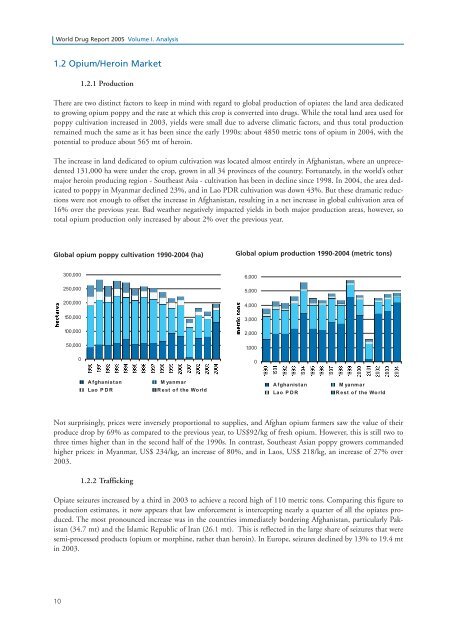World Drug Report 2005 - United Nations Office on Drugs and Crime
World Drug Report 2005 - United Nations Office on Drugs and Crime
World Drug Report 2005 - United Nations Office on Drugs and Crime
You also want an ePaper? Increase the reach of your titles
YUMPU automatically turns print PDFs into web optimized ePapers that Google loves.
<str<strong>on</strong>g>World</str<strong>on</strong>g> <str<strong>on</strong>g>Drug</str<strong>on</strong>g> <str<strong>on</strong>g>Report</str<strong>on</strong>g> <str<strong>on</strong>g>2005</str<strong>on</strong>g> Volume I. Analysis<br />
1.2 Opium/Heroin Market<br />
1.2.1 Producti<strong>on</strong><br />
There are two distinct factors to keep in mind with regard to global producti<strong>on</strong> of opiates: the l<strong>and</strong> area dedicated<br />
to growing opium poppy <strong>and</strong> the rate at which this crop is c<strong>on</strong>verted into drugs. While the total l<strong>and</strong> area used for<br />
poppy cultivati<strong>on</strong> increased in 2003, yields were small due to adverse climatic factors, <strong>and</strong> thus total producti<strong>on</strong><br />
remained much the same as it has been since the early 1990s: about 4850 metric t<strong>on</strong>s of opium in 2004, with the<br />
potential to produce about 565 mt of heroin.<br />
The increase in l<strong>and</strong> dedicated to opium cultivati<strong>on</strong> was located almost entirely in Afghanistan, where an unprecedented<br />
131,000 ha were under the crop, grown in all 34 provinces of the country. Fortunately, in the world’s other<br />
major heroin producing regi<strong>on</strong> - Southeast Asia - cultivati<strong>on</strong> has been in decline since 1998. In 2004, the area dedicated<br />
to poppy in Myanmar declined 23%, <strong>and</strong> in Lao PDR cultivati<strong>on</strong> was down 43%. But these dramatic reducti<strong>on</strong>s<br />
were not enough to offset the increase in Afghanistan, resulting in a net increase in global cultivati<strong>on</strong> area of<br />
16% over the previous year. Bad weather negatively impacted yields in both major producti<strong>on</strong> areas, however, so<br />
total opium producti<strong>on</strong> <strong>on</strong>ly increased by about 2% over the previous year.<br />
Global opium poppy cultivati<strong>on</strong> 1990-2004 (ha)<br />
Global opium producti<strong>on</strong> 1990-2004 (metric t<strong>on</strong>s)<br />
300,000<br />
250,000<br />
200,000<br />
150,000<br />
100,000<br />
50,000<br />
0<br />
6,000<br />
5,000<br />
4,000<br />
3,000<br />
2,000<br />
1,000<br />
0<br />
Afghanistan M yanmar<br />
Lao P DR<br />
Rest of the <str<strong>on</strong>g>World</str<strong>on</strong>g><br />
Afghanistan M yanmar<br />
Lao P DR<br />
Rest of the <str<strong>on</strong>g>World</str<strong>on</strong>g><br />
Not surprisingly, prices were inversely proporti<strong>on</strong>al to supplies, <strong>and</strong> Afghan opium farmers saw the value of their<br />
produce drop by 69% as compared to the previous year, to US$92/kg of fresh opium. However, this is still two to<br />
three times higher than in the sec<strong>on</strong>d half of the 1990s. In c<strong>on</strong>trast, Southeast Asian poppy growers comm<strong>and</strong>ed<br />
higher prices: in Myanmar, US$ 234/kg, an increase of 80%, <strong>and</strong> in Laos, US$ 218/kg, an increase of 27% over<br />
2003.<br />
1.2.2 Trafficking<br />
Opiate seizures increased by a third in 2003 to achieve a record high of 110 metric t<strong>on</strong>s. Comparing this figure to<br />
producti<strong>on</strong> estimates, it now appears that law enforcement is intercepting nearly a quarter of all the opiates produced.<br />
The most pr<strong>on</strong>ounced increase was in the countries immediately bordering Afghanistan, particularly Pakistan<br />
(34.7 mt) <strong>and</strong> the Islamic Republic of Iran (26.1 mt). This is reflected in the large share of seizures that were<br />
semi-processed products (opium or morphine, rather than heroin). In Europe, seizures declined by 13% to 19.4 mt<br />
in 2003.<br />
10

















